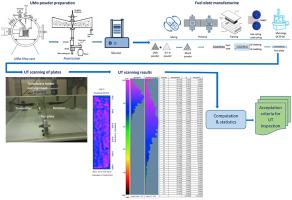当前位置:
X-MOL 学术
›
Prog. Nucl. Energy
›
论文详情
Our official English website, www.x-mol.net, welcomes your feedback! (Note: you will need to create a separate account there.)
Methodology for ultrasonic inspection of dispersion type U–Mo fuel plates
Progress in Nuclear Energy ( IF 2.7 ) Pub Date : 2020-12-01 , DOI: 10.1016/j.pnucene.2020.103572 María J. Alarcón , Mario Barrera , José Hernández , Jaime Lisboa , Luis Olivares , Alberto Navarrete
Progress in Nuclear Energy ( IF 2.7 ) Pub Date : 2020-12-01 , DOI: 10.1016/j.pnucene.2020.103572 María J. Alarcón , Mario Barrera , José Hernández , Jaime Lisboa , Luis Olivares , Alberto Navarrete

|
Abstract Nuclear fuel based on uranium-molybdenum alloys (U–Mo) showed a promising performance under irradiation tests, except for an undesirable interaction between the U–Mo fuel particles and the aluminum matrix. This development requires new methods and evaluation criteria for inspection of this fuel. Non-destructive analysis techniques, such as Ultrasonic Test (UT), can play a key role in the characterization and in-pile monitoring of test fuel plates, in particular, for the anisotropic fuel core. This paper proposes the establishment of a relationship between attenuation and transmission effects for U–Mo fuel plates with different uranium loads, based on mathematical processing of UT signals. For this purpose, the Chilean Nuclear Energy Commission (CCHEN) manufactured a set of 8 dispersion type test plates, with uranium loads from 1 to 8 gU/cm3. The U–Mo fuel plates were evaluated in transmission mode with a Panametrics PR 5800 pulser-receiver ultrasonic system, using frequencies of 20 and 25 MHz. The data set collected for each plate was processed using the Fourier Function transform of the data function in MATLAB®. The obtained results showed that the attenuation coefficient of the ultrasonic waves increased linearly as a function of the uranium load. From 12.3 dB/mm for 1 gU/cm3 to 74.2 dB/mm, for 8 gU/cm3. The transmission percentage of the signal reduces linearly as a function of uranium load and the grain boundaries present in the Al cladding, decreasing from 66.7% for 1 gU/cm3 to 9.1% for 8 gU/cm3. In conclusion, the uranium load and the metal forming processes strongly affects the response of the fuel plates subjected to UT scanning. These results established an acceptance criterion for fuel plates based on this response, and the transformations experienced by the fissile U–Mo material.
中文翻译:

分散型 U-Mo 燃料板的超声波检测方法
摘要 基于铀钼合金 (U-Mo) 的核燃料在辐照试验中表现出良好的性能,但 U-Mo 燃料颗粒与铝基体之间存在不良相互作用。这种发展需要新的方法和评估标准来检查这种燃料。超声波测试 (UT) 等无损分析技术可以在测试燃料板的表征和堆内监测中发挥关键作用,尤其是对于各向异性燃料堆芯。本文基于对 UT 信号的数学处理,提出了不同铀负载的 U-Mo 燃料板的衰减和传输效应之间的关系。为此,智利核能委员会 (CCHEN) 制造了一套 8 个分散型试验板,铀负载从 1 到 8 gU/cm3。U-Mo 燃料板使用 Panametrics PR 5800 脉冲发生器-接收器超声系统在传输模式下进行评估,使用频率为 20 和 25 MHz。使用 MATLAB® 中数据函数的傅立叶函数变换处理为每个板收集的数据集。获得的结果表明,超声波的衰减系数作为铀负载的函数线性增加。从 12.3 dB/mm(1 gU/cm3)到 74.2 dB/mm(8 gU/cm3)。信号的传输百分比作为铀负载和铝包层中存在的晶界的函数线性降低,从 1 gU/cm3 的 66.7% 降低到 8 gU/cm3 的 9.1%。总之,铀负载和金属形成过程强烈影响燃料板经受 UT 扫描的响应。
更新日期:2020-12-01
中文翻译:

分散型 U-Mo 燃料板的超声波检测方法
摘要 基于铀钼合金 (U-Mo) 的核燃料在辐照试验中表现出良好的性能,但 U-Mo 燃料颗粒与铝基体之间存在不良相互作用。这种发展需要新的方法和评估标准来检查这种燃料。超声波测试 (UT) 等无损分析技术可以在测试燃料板的表征和堆内监测中发挥关键作用,尤其是对于各向异性燃料堆芯。本文基于对 UT 信号的数学处理,提出了不同铀负载的 U-Mo 燃料板的衰减和传输效应之间的关系。为此,智利核能委员会 (CCHEN) 制造了一套 8 个分散型试验板,铀负载从 1 到 8 gU/cm3。U-Mo 燃料板使用 Panametrics PR 5800 脉冲发生器-接收器超声系统在传输模式下进行评估,使用频率为 20 和 25 MHz。使用 MATLAB® 中数据函数的傅立叶函数变换处理为每个板收集的数据集。获得的结果表明,超声波的衰减系数作为铀负载的函数线性增加。从 12.3 dB/mm(1 gU/cm3)到 74.2 dB/mm(8 gU/cm3)。信号的传输百分比作为铀负载和铝包层中存在的晶界的函数线性降低,从 1 gU/cm3 的 66.7% 降低到 8 gU/cm3 的 9.1%。总之,铀负载和金属形成过程强烈影响燃料板经受 UT 扫描的响应。

























 京公网安备 11010802027423号
京公网安备 11010802027423号